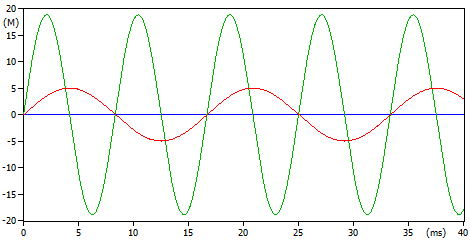When I have a capacitor connected to an AC voltage source, we can get from i=C*dv/dt the current through the capacitor (therefore through the voltage source). Than we can multiply the voltage across it with the current and we get: Power_over_capacitor(t) = 0.5im*vm*sin(2wt) During half cycly it gets power from the voltage source. I dont understand however what does the negative power mean? when the capacitor discharges - where does the power go to? The voltage source, as far as I understand, always provide power. So how can it get the power from the capacitor and where does it go to?
-
1\$\begingroup\$ When I have a capacitor connected to an AC voltage source How? In series? Parallel? Draw the schematic or find a suitable picture using a Google search. Realize that a capacitor is a reactive component and unlike a resistor (which is a resistive component) a capacitor cannot dissipate power. where does the power go to? The energy or charge (not the power!!!) flows back into the voltage source. A voltage source will either deliver or absorb current in order to maintain the voltage. \$\endgroup\$– BimpelrekkieCommented Dec 1, 2020 at 14:08
3 Answers
It may be a voltage source but it can still take reverse current and the "negative power" goes back into the voltage source because the current is reversed. In a real supply this may not be possible of course (think voltage regulator) but, in something that behaves like an ideal voltage source, then energy is returned.
+1 to Andy. The capacitor stores energy (e.g. \$\frac{1}{2}Cv^2)\$ during first \$\frac{1}{4}\$ cycle, then gives it up during the next \$\frac{1}{4}\$ cycle. This is just how capacitors do business.
In this plot below (from simple simulation of your circuit) the red trace is voltage across the cap, green is power,\$v(t)\times i(t)\$.
And here is a plot of the power (blue trace) with the energy (red trace). This is probably what @analogsystemsrf is thinking of with his answer (energy, not power).
If I recall rightly, sin(aT) * sin(aT) is
- 0.5 [ 1 + sin (2aT) ]
so there is no negative result.
-
3\$\begingroup\$ its wrong, because if the voltage over the capacitor is sin(wt), than the current is Cdv/dt = Cw*cos(wt) \$\endgroup\$– JonathanCommented Dec 1, 2020 at 15:24
-
1\$\begingroup\$ I think you are thinking energy @analogsystemsrf, not power. \$\endgroup\$ Commented Dec 1, 2020 at 17:14



